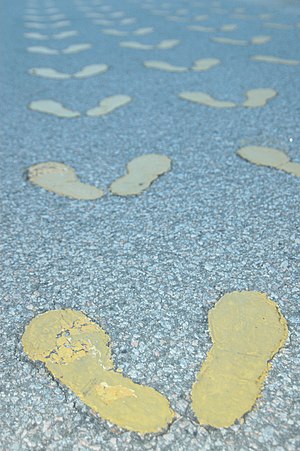The corporal took as his main duty the relating of boot-camp tales, doubtless exaggerated. We were desperate for information. Marine boot camp loomed as an ordeal about which

The first activity of a new recruit is to stand in his or her first formation, marked by these yellow footprints (Photo credit: Wikipedia)
civilians knew nothing except by reputation. Today, with the movie Full Metal Jacket and in the era of You Tube, videos of drill instructors screaming at recruits fill the air. Not then.
The truck pulled up to a long yellow building named Receiving Barracks (Marine colors are red and gold, hence the buildings at San Diego are gold with red trim. At Parris Island, they are red with gold trim). Flanking the entrance sit two small Japanese cannon captured at Iwo Jima.


9 Responses to Fifty years of the Marine Corps
This great information & what a great story!!!!!!! I hope there’s more coming! You were a great looking recruit!
You’re kind, Danny, but I was in a state of shock the entire first month. Semper Fi.
Semper fi indeed! More please!
Aye aye, ma’am. Pfc. PANNILL
Your post has captivated my interest, and I can’t wait to read what happened next!
Just now getting to this blog, and looking forward to reading more about your experience as a Marine. Hopefully over Christmas, I’ll get to read the previous posts. Thanks for sharing, Bill, and Happy Thanksgiving to you and Molly!
Excellent post. I was checking constantly this blog and I am impressed!
Very useful information specifically the last part 🙂 I care for such info a lot.
I was looking for this certain info for a long time.
Thank you and good luck.
Hi everyone, it’s my first pay a quick visit at this web
page, and post is in fact fruitful for me, keep up posting these
types of articles or reviews.
Your style is very unique in comparison to other folks I’ve read stuff from.
Thanks for posting when you’ve got the opportunity, Guess I will just book mark this
page.